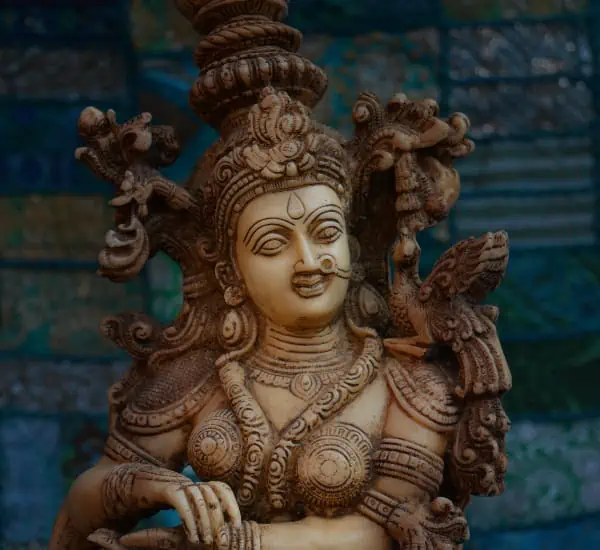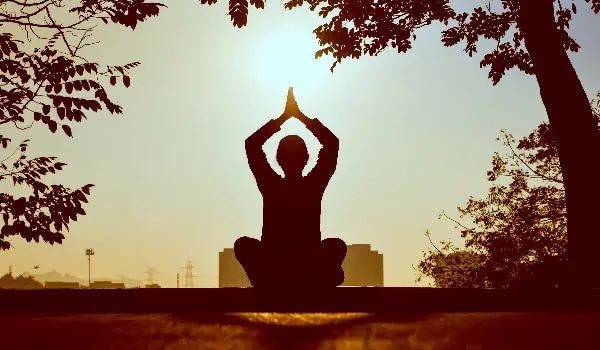The Bhagavad Gita, a sacred text in Hindu philosophy and a part of the Upanishads places significant emphasis on the concept of yoga, particularly karma yoga and following one’s dharma (duty).
Krishna, the karma yogi, serves as a guide for Arjuna, elucidating various paths of yoga, including Karma, Bhakti, Jnana, and Dhyana yoga, through profound dialogues in the Upanishads, highlighting the importance of dharma.
The battlefield setting is symbolic, representing individuals’ moral and ethical struggles in life, reflecting their spiritual path toward liberation. It’s akin to nature’s way of mirroring the world’s dilemmas.
Distinct paths of yoga, as outlined in the Upanishads, are discussed across chapters and verses, each with unique practices and outcomes. The yogi explores these paths through Sāṇkhya philosophy, adhering to the principles of dharma.
For instance, pranayama is mentioned as a part of the broader yogic discipline, including jñāna yoga (the yoga of knowledge) and classical yoga, which leads to self-realization. Dedicated yoga practitioners often follow this yoga doctrine.
Contents
- 1 Exploring Paths of Yoga: Karma and Jnana
- 2 Philosophy of Yoga in the Bhagavad Gita
- 3 Krishna’s Definitions of Yoga
- 4 Beyond Asana: Deepening Practice
- 5 Modern Relevance of Gita’s Teachings
- 6 Embracing Yoga Philosophy
- 6.1 FAQ 1: What are Krishna’s definitions of Yoga?
- 6.2 FAQ 2: How can understanding yoga philosophy and its relation with the Bhagavad Gita improve my practice?
- 6.3 FAQ 3: Can I apply principles from Bhagavad Gita’s teachings in modern life?
- 6.4 FAQ 4: Is there more to yoga than just physical exercise?
- 6.5 FAQ 5: How can I delve deeper into the philosophy of yoga?
- 6.6 Was this helpful?
Exploring Paths of Yoga: Karma and Jnana
Unraveling Karma Yoga
Karma Yoga, or the path of selfless action, is a significant aspect of the Bhagavad Gita, just like dharma, bhakti, and the pursuit of jñāna (wisdom). Dharma teaches us about performing our duty, karma yoga, without worrying about the outcome. It’s all about aligning the mind with nature.
- As a karma yogi practicing dharma, you perform good deeds without expecting rewards, embodying the principles of jñāna yoga (using correct knowledge). The word “karma” signifies mindful, selfless action, and you enhance this selfless path through dhyāna (deep meditation).
- The keyword here is ‘selfless’. You act because it’s your dharma, not for what you’ll get in return; this is the essence of karma yoga. It’s a mindset that aligns with nature.
This idea helps us grasp Arjuna’s dilemma on the battlefield, a struggle deeply rooted in dharma, influenced by karma yoga, jñāna yoga, and dhyāna practices. Torn between his dharma as a warrior and his love for his family, he stood at the crossroads of this chapter in his life, the nature of his dilemma echoing in every verse of his story.
Delving into Jnana Yoga
Next up, we have Jnana Yoga. This is the path of knowledge and wisdom.
- Jnana yoga is not just about book smarts or memorizing each chapter and verse; it’s about understanding life’s dharma and the mysteries of nature, learning this correct knowledge, and applying it to life.
- As described in the text, a person following the path of jñāna and karma yoga seeks truth and enlightenment through knowledge and exploring nature.
Now, let’s discuss how these two paths, jñāna yoga, and karma yoga, are intertwined in this sacred text.
Interconnection of Karma and Jnana Yoga
Karma and jñāna yoga are like two verses in a chapter, both crucial in achieving moksha or spiritual liberation. The approaches differ slightly in focus, but jñāna and karma yoga complement each other perfectly.
Both paths of karma yoga and jñāna, as described in various verses and chapters, lead to the same destination — moksha or liberation from earthly desires and suffering. Throughout the Bhagavad Gita, many verses mention actions (karma marga) and wisdom (jñāna) as essential to attaining spiritual liberation.
So there you have it! Two classical yogic paths woven throughout the Bhagavad Gita can guide your spiritual journey as you find inspiration in each verse.
Whether you walk the path of karma yoga, the path of selfless action, or seek wisdom through verse in jñāna yoga, remember that both will lead you toward spiritual fulfillment.
Philosophy of Yoga in the Bhagavad Gita
Yoga as a Philosophical System
The Bhagavad Gita presents the different paths of yoga as a philosophical system. Each of the yoga systems is about finding peace and understanding our true selves.
As the epic tale unfolds, Krishna introduces us to different forms of yoga. These include karma (action), jnana (knowledge), bhakti (devotion), and dhyana (meditation).
Krishna’s Definitions of Yoga
Diverse Definitions of Yoga
In his conversations with Arjuna, God Krishna offers us different ways to understand “yoga.” It’s like he’s handing us a box full of tools and saying, “Here you go. Pick the one that fits you best.” Throughout the Bhagavad Gita, here are some of the descriptions Krishna uses to define yoga:
- Skill in action.
- The science of self-realization.
- The path to supreme peace.
- Elevated awareness of all life.
- Connection to universal consciousness.
- Renunciation of sense objects and material desires.
- The process of focusing the mind
- Devotion to the Supreme Being (God)
These are just a few examples of how we can use the wisdom of the Bhagavad Gita to understand what it means to live a yogi lifestyle.
Yoga for Holistic Understanding
Each definition is a piece of a larger puzzle. They come together to form a complete picture.
- Think about it like this: You’re trying to practice yoga as a spiritual path, but if you focus on only one type of yoga, you’ve only got part of the recipe. That’s not going to work, right?
- By understanding and adopting all ten definitions — for example, by acquiring correct knowledge through jnana yoga and applying those principles through karma yoga (action) — we have the whole yoga recipe!
Unity and Equanimity in Yoga
In Karma yoga, unity and equanimity are common threads that define the practice.
- Yoga is about uniting body, mind, and spirit; karma also plays a role in this unity by joining good intentions with proper actions.
- Karma and yoga teach equanimity, meaning staying calm no matter what life throws at you.
Inner Peace Through Yoga
Inner peace is another biggie in god Krishna’s yoga playbook. And who doesn’t want some of that?
- Practicing yoga is like finding that calm spot in the middle of a storm.
- Dhyāna yoga, the yoga of meditation, specifically aims to deepen one’s awareness and elevate the consciousness.
- Over time, dhyāna or meditation yoga brings us closer to our true self and the supreme reality, achieving a state of complete inner peace.
Multiple Interpretations for Greater Significance
But why does the god Krishna give us so many interpretations?
Well, it’s because he, as the supreme being, wants us to understand yoga on our terms.
It’s like when your yoga teacher poses a hypothetical question while you’re holding a yoga pose. Each student in the class will likely have a different answer based on their own experience or interpretation. There isn’t just one correct answer!
Beyond Asana: Deepening Practice
Many people equate yoga with physical postures or asanas. But the Bhagavad Gita teaches us that yoga is more than just a workout.
Yoga: More Than Just Asanas
Even though there are many benefits of yoga twists, Yoga isn’t just about twisting your body into pretzel shapes. Yoga is a holistic practice that includes meditation (dhyana), devotion (bhakti), and yoga postures.
- Meditation helps you achieve a calm mind.
- Devotion connects you to something bigger than yourself.
Importance of Dhyana and Bhakti
In the Bhagavad Gita, there’s a lot of emphasis on these two aspects of yoga.
- Dhyana, or meditation, helps quiet our monkey minds.
- Bhakti, or devotion in yoga, allows us to surrender to the divine.
Mind-body-spirit Integration
True yoga practice involves integrating your mind, body, and spirit. This means aligning your yoga-inspired thoughts, actions, and feelings towards a common goal.
- The mind directs focus.
- The body performs actions.
- The spirit provides motivation.
Road to Self-realization
Deepening one’s yoga practice can lead to self-realization. This is when you truly understand yourself beyond your name and physical form.
Here are some tips for integrating yoga into your spiritual practice:
- Begin with basic asanas to prepare the body.
- Incorporate pranayama (breath control) for mental clarity.
- Meditate regularly for inner peace.
- Practice bhakti for spiritual connection.
According to the Bhagavad Gita, these yoga practices help peel off layers of illusion until only the truth remains — this is self-realization.
Modern Relevance of Gita’s Teachings
Applying the Gita’s Teachings to Modern Life
The Bhagavad Gita’s teachings are a great stress-buster. Yoga practices help us cope with modern life stresses like anxiety or depression. Yoga is all about understanding the reality of life, not getting lost in the Tama (darkness) of non-yoga practices.
For example, consider the karma yoga principle of detached action. This principle encourages us to perform our duties without attachment to the results. It’s a powerful tool for managing stress and anxiety; without being so focused on the potential for success or the possibility of failure, we can be fully present in each moment.
Decision-Making through Gita Principles
Equanimity is another crucial concept from the Gita. Yoga teaches us to remain calm and composed, no matter what happens. Practicing yoga can be a game-changer in decision-making situations.
Imagine you’re facing a tough choice at work, school, or during your yoga practice. By practicing yoga and its principle of equanimity, you can make decisions without getting swayed by emotions or external pressures.
Yoga Philosophy for Mental Health
Yoga isn’t just about physical exercise but also mental well-being. The yoga philosophy outlined in the Gita can guide us towards inner peace and happiness.
Research has shown that regular yoga practice can reduce symptoms of mental health disorders like depression and anxiety.
Universal Appeal Beyond Religion
The best part? The teachings of the Bhagavad Gita, a fundamental text in yoga, have universal appeal – they’re relevant for everyone, regardless of religious beliefs or yoga experience.
People from all walks of life can benefit from these timeless yoga principles. They offer practical yoga wisdom on how to live a meaningful and fulfilling life.
Embracing Yoga Philosophy
The teachings of the Bhagavad Gita offer a profound exploration of yoga that extends beyond physical postures.
The philosophical underpinnings, as embodied in Krishna’s definitions and the paths of Karma and Jnana yoga, deepen our understanding and practice. In an era where the essence of yoga is often reduced to fitness regimens, the wisdom from this ancient scripture offers a holistic approach that can enhance modern life.
The relevance of these yoga teachings today underscores their timeless wisdom. By integrating yoga and its principles into daily routines, individuals can cultivate mindfulness, inner peace, and spiritual growth.
We invite you to delve deeper into the philosophy of yoga as presented in the Bhagavad Gita and enrich your journey toward self–realization. You can pick up your copy of this epic tale full of yoga wisdom by shopping here.
FAQ 1: What are Krishna’s definitions of Yoga?
Krishna defines Yoga in various ways throughout the Bhagavad Gita. Some examples include Yoga as skill in action, equanimity, the supreme secret of ultimate reality, supreme knowledge, devoted worship, and ultimate bliss.
FAQ 2: How can understanding yoga philosophy and its relation with the Bhagavad Gita improve my practice?
Understanding yoga philosophy enhances your practice by providing a deeper context for your physical postures and breathing exercises. It also helps cultivate mindfulness and inner peace.
FAQ 3: Can I apply principles from Bhagavad Gita’s teachings in modern life?
Absolutely! The principles outlined in the Bhagavad Gita, like duty without attachment to results (Karma Yoga) or path of knowledge (Jnana Yoga), are timeless and can be integrated into everyday life.
FAQ 4: Is there more to yoga than just physical exercise?
Yes, traditional yoga encompasses much more than just physical exercise.
Yoga includes ethical living guidelines (Yama & Niyama), breath control (Pranayama), concentration techniques (Dharana), meditation (Dhyana), and ultimate union with universal consciousness (Samadhi).
FAQ 5: How can I delve deeper into the philosophy of yoga?
You can delve deeper by studying ancient texts like Bhagavad Gita or Patanjali’s Yoga Sutras, attending philosophy-focused yoga classes, workshops, or retreats, and incorporating the teachings into your daily life.





